#Spring loaded terminal blocks
Explore tagged Tumblr posts
Text
The Advantages of Panel-Mounted Terminal Blocks with Spring Clamps
Panel-mounted terminal blocks with spring clamps are an essential component in electrical and electronic systems, offering numerous advantages over traditional screw-type terminal blocks. Panel mounted terminal blocks spring clamps in India, manufactured and supplied by Elmex Controls Pvt. Ltd. are gaining popularity around the world due to their reliability, ease of use, and time-saving capabilities.
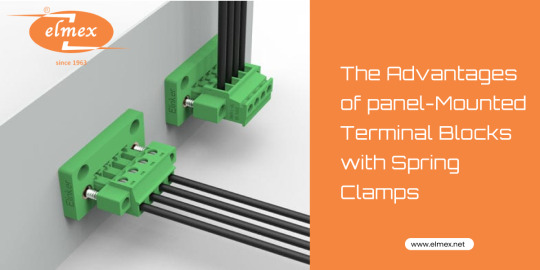
These clamps have become increasingly popular in India due to their numerous advantages over traditional wiring methods. In this article, let’s explore the importance of using panel-mounted terminal blocks with spring clamps, including enhanced reliability, improved safety, and superior performance.
Importance:
Firstly, their reliability is crucial for ensuring the smooth operation of electrical systems. Loose connections or faulty wiring can lead to interruptions in the power supply, equipment malfunction, or even safety hazards. Panel mounted terminal blocks spring clamps in India provide secure and stable connections, reducing the risk of such issues. This reliability is particularly vital in industries where downtime can result in substantial financial losses.
Secondly, the safety features offered by these terminal blocks play a significant role in protecting both equipment and personnel. Loose connections and short circuits can lead to electrical arcing, overheating, or electrical shocks. The spring clamps and clear separation between conductors in panel-mounted terminal blocks minimize these risks, making them a safer alternative to traditional wiring methods.
Moreover, the performance benefits of panel-mounted terminal blocks contribute to the overall efficiency and productivity of electrical systems. By maintaining optimal contact and reducing electrical resistance, these terminal blocks minimize power loss and voltage drops. This improves the performance of equipment, reduces energy consumption, and lowers operating costs.
Additionally, the ease of installation and maintenance provided by terminal blocks saves time and effort. Troubleshooting becomes simpler due to organized wiring and easy accessibility. Wiring errors are minimized, leading to quicker identification and resolution of issues. Furthermore, the flexibility and adaptability of terminal blocks allow for system modifications or expansions without the need for extensive rewiring, providing cost-effective solutions.
Reliability:
Reliability is a crucial aspect of any electrical system, and panel-mounted terminal blocks with spring clamps offer notable advantages in this regard. These terminal blocks provide secure and stable connections, ensuring consistent and uninterrupted electrical flow. The spring clamps exert constant pressure on the conductors, maintaining a reliable connection even in demanding environments with vibrations or temperature variations. This feature reduces the risk of loose connections, which can lead to electrical faults, downtime, and costly repairs.
Furthermore, panel-mounted terminal blocks simplify maintenance and troubleshooting processes. With traditional wiring methods, locating and fixing faulty connections can be time-consuming and challenging. However, with terminal blocks, the wiring is organized and easily accessible, allowing quick identification and resolution of issues. This enhances the overall reliability of the system, minimizing downtime and optimizing productivity.

Safety:
Safety is of utmost importance in electrical installations, and panel-mounted terminal blocks with spring clamps offer significant safety benefits. These terminal blocks have built-in features that help prevent electrical hazards. The spring clamps ensure a secure and vibration-resistant connection, reducing the risk of loose connections that can cause electrical arcing or overheating. Additionally, terminal blocks provide a clear separation between conductors, minimizing the chances of accidental contact and short circuits.
Panel-mounted terminal blocks also simplify installation and reduce the risk of wiring errors. The spring clamps allow for easy and tool-free wiring, eliminating the need for twisting and soldering wires. This reduces the chances of human error, such as loose connections or crossed wires, which can compromise safety. The clearly labelled and organized terminals make it easier to identify and verify correct wiring, ensuring proper circuit configurations.
Moreover, terminal blocks are designed to withstand high voltages and currents, offering excellent electrical insulation. They are manufactured using high-quality materials that provide resistance to heat, chemicals, and other environmental factors. These attributes enhance the overall safety and durability of the electrical system.

Performance:
Panel mounted terminal blocks spring clamps in India offered by Elmex Controls, deliver superior performance compared to traditional wiring methods offered by other companies. The spring clamps provide consistent pressure, maintaining optimal contact between the conductors. This ensures low electrical resistance, minimizing power loss and voltage drops. The reliable connection offered by terminal blocks improves the overall efficiency of the system, resulting in better performance and reduced energy consumption.
Additionally, panel-mounted terminal blocks facilitate easy customization and flexibility. They allow for quick and hassle-free reconfiguration or expansion of the electrical system, without the need for rewiring. This feature is particularly advantageous in industrial settings where frequent changes and upgrades are common.
Furthermore, terminal blocks offer compatibility with a wide range of wire sizes and types. They can accommodate various conductor materials, such as solid, stranded, or flexible wires. This versatility allows for greater flexibility in system design and installation.
Final Thoughts:
Panel mounted terminal blocks spring clamps in India have revolutionized electrical installations in India, offering reliability, safety, and superior performance. Their secure connections, simplified troubleshooting, enhanced safety features, and flexibility make them the preferred choice for a wide range of applications, from industrial automation to building installations. Embracing these terminal blocks supplied by Elmex Controls Pvt. Ltd. can significantly improve electrical systems in terms of efficiency, durability, and overall performance.
#Panel mounted terminal blocks spring clamp India#Component housing block spring clamp#Spring loaded terminal blocks#Plug & socket terminal block spring clamp#Micro terminal block spring clamp#spring loaded terminal connector#spring type terminal block#solar pv panel junction box India#solar pv branch connector India
2 notes
·
View notes
Text
How to Prepare Your Fleet for Springfield's Seasonal Changes
Springfield doesn’t believe in stable weather. Summers roast tires. Winters freeze fuel lines. Spring rains flood streets. Fall dumps leaves that clog air intakes. Fleet owners who ignore these shifts end up with stranded trucks, delayed deliveries, and higher repair bills. Regular Truck Repair Near Me searches mean something went wrong. Planning ahead keeps rigs rolling without surprise breakdowns.
Seasonal maintenance isn’t just about oil changes. Everything gets affected—tires, cooling systems, brakes, batteries, fuel systems. Springfield’s shifting climate punishes unprepared fleets. Smart operators get ahead of problems before they turn into emergency Mobile Truck Repair calls.

Seasonal Maintenance Tips for Springfield Fleet Operators
Spring – Pollen, Rain, and Rising Temperatures
Spring looks harmless until truck filters choke on pollen and moisture causes electrical failures. Engines run differently after cold months. Early maintenance stops small issues from turning into major problems.
Inspect air filters – Pollen clogs up intakes fast, restricting airflow and hurting engine performance.
Check for winter damage – Cold months crack hoses, corrode battery terminals, and weaken belts.
Test wipers and lights – Spring storms bring heavy rain. Bad wipers and dim headlights mean unsafe driving.
Monitor cooling systems – Temps rise, and cooling system problems start showing up. Catch them early.
Fleets that skip spring maintenance end up needing last-minute Truck Repair when summer heat kicks in.
Summer – Overheated Engines, Tire Blowouts, and AC Failures
High heat does more than make drivers sweat. Trucks feel it too. Cooling systems work overtime. Tires expand and blow. Batteries drain faster. Keeping fleets operational means addressing summer’s biggest threats early.
Inspect coolant levels and radiator – Summer kills weak cooling systems. Engines overheat without proper maintenance.
Rotate and check tire pressure – Hot pavement destroys tires. Incorrect pressure makes blowouts more likely.
Ensure AC systems work – No driver wants to haul loads in a cab that feels like an oven.
Monitor batteries – Extreme heat reduces battery life faster than people expect.
Ignoring summer maintenance? That leads straight to emergency Truck Repair Shop Near Me calls when rigs overheat on Route 66.
Fall – Cooling Temperatures and Hidden Issues
Fall looks calm, but hidden problems creep up. Cooling temps mask underlying issues. If something struggles in fall, it fails in winter.
Check brakes – Ice and wet leaves make stopping harder. Worn brake pads turn into safety hazards.
Inspect fuel filters – Dirty filters clog injectors. Colder temps make fuel system issues worse.
Prepare for colder starts – Batteries lose power when temperatures drop. Test them before winter.
Fix minor leaks – Small coolant leaks turn into full system failures when freezing weather arrives.
Fleet operators who ignore fall maintenance get hit hardest when winter rolls in. Waiting means costly Truck Repair Shop visits.
Winter – Frozen Fuel, Weak Batteries, and Brake System Struggles
Cold weather turns diesel fuel thick. Batteries lose strength. Metal contracts, making systems work harder. Springfield winters test every part of a truck.
Use winterized fuel additives – Prevent frozen fuel lines and thick diesel that won’t flow properly.
Test block heaters and glow plugs – Cold starts destroy engines when pre-heating systems fail.
Check tire traction – Snow and ice reduce grip. Worn tires turn highways into danger zones.
Ensure air brake systems work – Moisture in brake lines freezes, causing failures in emergency situations.
Winter breakdowns leave drivers stranded in freezing temperatures. That’s not just a delay—it’s dangerous. Fleet owners who prepare early avoid last-minute Truck Repair emergencies.
Why Choose AES Truck Repair for Fleet Maintenance?
Fleet operators need reliable truck service. AES Truck Repair keeps fleets running strong, handling every season’s challenges. Here’s why truckers trust us.
1. Comprehensive Seasonal Inspections
Spring, summer, fall, winter—each brings unique problems. Our team catches seasonal damage before it turns into major failures.
2. Mobile Service Means Less Downtime
Towing trucks to a shop wastes time. Our Mobile Truck Repair crew comes directly to your fleet, saving hours of lost productivity.
3. Expert Technicians with Heavy-Duty Experience
Fleet maintenance isn’t just about oil changes. We inspect cooling systems, fuel injectors, electrical components, brakes, and suspension to ensure full reliability.
4. Tire Replacements and Pressure Checks
Tire issues lead to major accidents. We check tread wear, rotate tires, and install new ones when needed.
5. Transparent Pricing with No Hidden Fees
Some shops sneak in extra costs. We provide clear, upfront pricing for all maintenance services.
6. Springfield’s Trusted Truck Repair Experts
Local trucking companies, long-haul operators, and independent drivers call us first. Our reputation keeps growing because we deliver top-tier service every time.
FAQs – Fleet Maintenance Questions for Springfield Truckers
Q1: How often should fleet trucks get preventative maintenance near Republic MO?
Regular check-ups every 10,000 miles keep trucks in peak condition. Seasonal inspections prevent surprise failures.
Q2: Does AES provide mobile fleet maintenance near Willard MO?
Yes. Our Mobile Truck Repair service brings maintenance directly to fleet yards, saving companies time and money.
Q3: What’s the most important system to check before winter in Springfield?
Fuel systems need attention first. Frozen fuel lines and failing block heaters prevent trucks from starting in freezing weather.
Q4: How does AES help fleet owners save money near Ozark MO?
Preventative maintenance reduces emergency repairs, extends vehicle lifespan, and improves fuel efficiency. Small fixes today prevent expensive breakdowns later.
Q5: Can AES Truck Repair handle large fleet servicing near Strafford MO?
Absolutely. We work with small businesses, owner-operators, and large trucking companies, offering customized fleet maintenance plans.
Q6: What’s the biggest maintenance mistake fleet owners make in Springfield?
Ignoring seasonal maintenance. Minor issues turn into major failures when trucks face extreme weather shifts.
Keep Your Fleet Road-Ready with AES Truck Repair
Springfield’s seasonal changes challenge every truck on the road. Smart fleet operators stay ahead of breakdowns by preparing early. AES Truck Repair provides expert maintenance, ensuring fleets operate smoothly all year.
📍 AES Mobile Truck Repair 📍 2190 N Westgate Ave, Springfield, MO 65802, United States 📞 Call: +1 (417) 855-9066
Stay ahead of the seasons. Call AES and keep your fleet rolling strong.
0 notes
Text
Connecting the Dots: Exploring the Types of Wire Connectors in Electronics
Wire connectors play a crucial role in the world of electronics, facilitating secure and reliable connections between wires and components. With a variety of types available, each designed for specific purposes, understanding the different wire connectors is essential for efficient electronic assembly and maintenance. Let's delve into the various types of wire connectors in electronics and their unique characteristics.
1. Crimp Connectors
Crimp connectors are widely used in electronics for creating permanent electrical connections. They consist of a metal sleeve that is crimped onto a wire using a specialized tool, creating a strong and secure bond. Crimp connectors come in various types, including ring terminals, spade terminals, butt connectors, and quick-connect terminals, each suited for different wire gauges and applications.
2. Screw Terminals
Screw terminals are another common type of wire connector used in electronics. They feature a screw mechanism that clamps down on stripped wire ends, creating a reliable electrical connection. Screw terminals are often found in terminal blocks, electrical switches, and power distribution panels, providing a convenient and adjustable way to connect and disconnect wires.
3. Wire Nuts
Wire nuts, also known as twist-on connectors, are used to join multiple wires together securely. They feature a threaded cap that twists onto the stripped ends of wires, creating a tight and insulated connection. Wire nuts are commonly used in residential and commercial electrical wiring for connecting wires within junction boxes, light fixtures, and electrical outlets.
4. Push-In Connectors
Push-in connectors, also referred to as push-in wire connectors or push-in terminals, offer a quick and tool-free way to connect wires. These connectors feature spring-loaded slots where stripped wire ends can be inserted, creating a secure connection without the need for twisting or crimping. Push-in connectors are often used in lighting fixtures, switches, and electrical appliances for easy installation and maintenance.
5. Terminal Blocks
Terminal blocks are modular connectors that provide a convenient way to connect multiple wires or components. They consist of insulated blocks with metal terminals or screws where wires can be attached. Terminal blocks come in various configurations, including barrier strips, DIN rail-mounted blocks, and PCB-mounted blocks, making them versatile for different electronic applications.
6. D-sub Connectors
D-sub connectors, named for their D-shaped metal shell, are commonly used for data and signal connections in electronics. They feature multiple pins arranged in rows, with different configurations such as DB9, DB15, and DB25. D-sub connectors are used in computer peripherals, audio/video equipment, and industrial automation systems for reliable data transmission.
7. JST Connectors
JST connectors, manufactured by Japan Solderless Terminal (JST) Corporation, are compact and reliable connectors commonly used in electronic devices and appliances. They come in various series and styles, including wire-to-board connectors, wire-to-wire connectors, and board-to-board connectors. JST connectors are known for their low profile, high current capacity, and secure locking mechanisms.
8. RJ Connectors
RJ connectors, short for Registered Jack connectors, are widely used in telecommunications and networking applications. They include RJ45 connectors for Ethernet connections, RJ11 connectors for telephone lines, and RJ12 connectors for data transmission. RJ connectors feature multiple contacts that align with corresponding pins in jacks or sockets, providing a standardized and reliable interface for data and voice communication.
Conclusion
The types of wire connectors in electronics are diverse and specialized, each serving a specific purpose in creating and maintaining electrical connections. From crimp connectors for secure terminations to push-in connectors for easy installations, the variety of connectors available allows for efficient and reliable electronic assembly. Understanding the characteristics and applications of these connectors is essential for electronics engineers, technicians, and hobbyists to ensure proper connectivity and functionality in electronic devices and systems.
0 notes
Text
Review, teardown, and testing of LRS-75-24 Mean Well power supply
General description
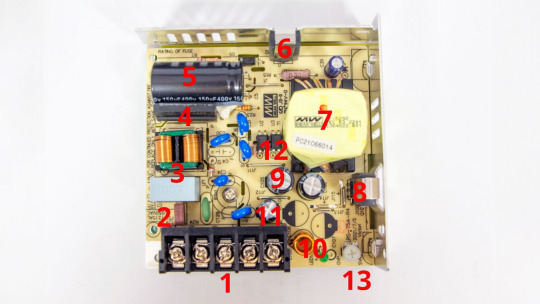
LRS-75-24 is a 24-volt power supply with a maximum current of 3.2 amperes. According to the manufacturer, the unit operates at a mains voltage of 100 to 240 volts without an additional switch. It has no PFC function. The supply measures approximately 4 × 4 × 1 1/5 inches (99 × 97 × 30 millimeters) and is made on a printed circuit board fixed to the base of the metal case. The top cover is perforated, and the holes are meant for passive cooling.

The input and output circuits are connected to a common screw block (1). From right to left, there are 3 terminals for the input line, neutral, and ground wires, and terminals 4 and 5 are the outputs: ground and +24V. The input voltage goes to the fuse and inrush current limiter (2), then to the RF interference filter (3), and finally, to the diode bridge (4). The inrush current limiter has no markings; apparently, it is just an NTC. The rectified mains voltage is supplied to the 150 uF, 400V capacitor (5) and then to the flyback converter built on an MW03A controller (located on the back side of the PCB), a TK750A60F transistor (6), and a transformer (7). The voltage from the secondary winding of the transformer is rectified by a Schottky diode HBR20150 (8) and supplied to storage capacitors 2×470uF 35V, and, through an additional LC filter (10) (11), goes to the output. The feedback circuit is classic; with TL431 (on the other side of the board), the feedback signal is transmitted to the PWM controller through one of the optocouplers (12); the second optocoupler forms a backup channel for overvoltage protection at the OVP output. The installed electrolytic capacitors are designed for operating temperatures up to 220F (105C). The bulkiest of them, the input one, is held on the board with compound.
Build quality is good.
The power transistor (6) and diode (8) are pushed against the metal case using spring brackets to dissipate heat. Their own housings are insulated using special shells.
Test conditions
Most tests are performed using Metering Setup #1 (https://teardownit.com/posts/power-control-unit-for-testing) at 80F (27C), 70% humidity, and 29.8 inHg pressure. The measurements were performed without preheating the power supply with a short-term load unless mentioned otherwise. The following values were used to determine the load level:


It should be noted that there is a slight overshoot; increasing the load slightly increases the output voltage.
Power-on parameters
Powering on at 100% load
Before testing, the power supply is turned off for at least 5 minutes with a 100% load connected. The oscillogram of switching to a 100% load is shown below (channel 1 is the output voltage, and channel 2 is the current consumption from the grid):
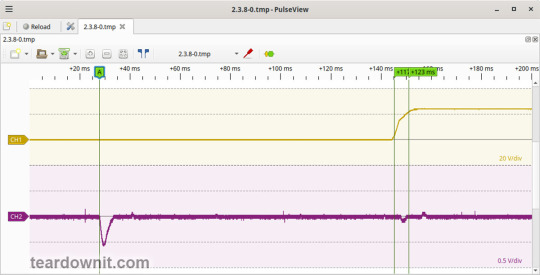
The picture shows three distinguishable phases of the power-on process:
When connected to the grid, the pulse of the input current charging the input capacitors has an amplitude of about 5.7 A and a duration of 6 ms.
Waiting for the power supply control circuit to start for about 117 ms.
(Output Voltage Rise Time) Starting the converter, increasing the output voltage, and entering the operating mode takes 6 ms.
(Turn On Delay Time) The entire process of entering the operating mode from the moment the device powers on is 123 ms.
(Output Voltage Overshoot) The switching process is aperiodic; there is no overshoot.
Power-off parameters
The power supply was turned off at 100% load, and the input voltage was nominal at the moment of powering off. The oscillogram of the shutdown process is shown below:
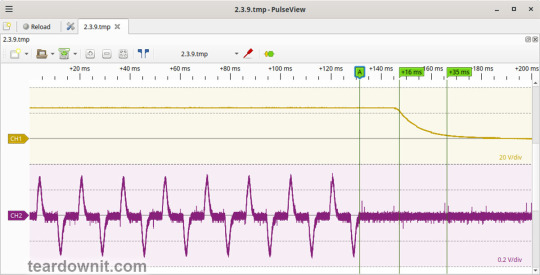
The oscillogram shows two phases of the shutdown process:
(Shutdown Hold-Up Time) The power supply continues to operate because the input capacitors hold charge until the voltage across them drops to a certain critical level, at which point maintaining the output voltage at the nominal level becomes impossible. The phase takes 16 ms.
(Output Voltage Fall Time) Reduction of the output voltage, stopping voltage conversion, and accelerating the voltage drop takes 19 ms.
(Output Voltage Undershoot) The shutdown process is aperiodic; there is no undershoot.
The amplitude of the current at 100% load before shutting down is approximately 3 A.
Output voltage ripple
100% load
At 100% load, the low-frequency ripple is approximately 20 mV.
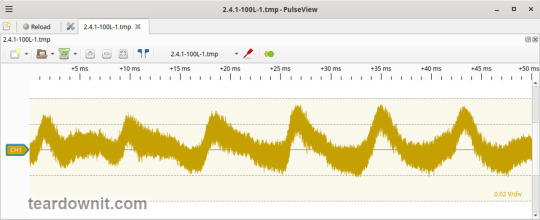
At 100% load, the ripple at the converter frequency is approximately 50 mVp-p.
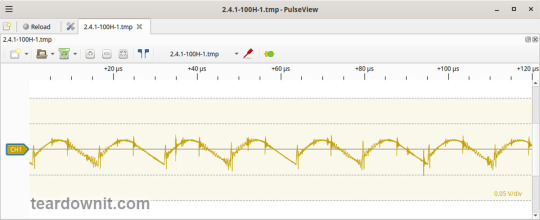
75% load
At 75% load, the low-frequency ripple is approximately 40 mV.

At 75% load, the ripple at the converter frequency is approximately 35 mVp-p.
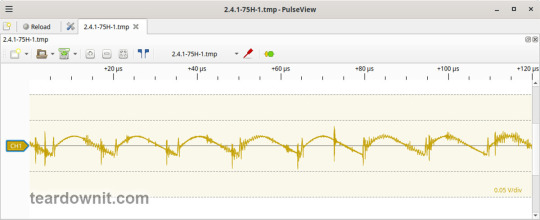
50% load
At 50% load, the low-frequency ripple is approximately 20 mV.

At 50% load, the ripple at the converter frequency is approximately 40 mVp-p.

10% load
At 10% load, the low-frequency ripple is approximately 10 mV.

At 10% load, the ripple at the converter frequency is approximately 20 mVp-p, and the noise is 80 mVp-p.
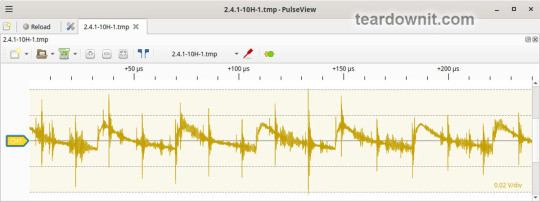
0% load
The no-load current consumption measured with a multimeter is 18 mA. The current consumption in this mode is predominantly reactive. In the supply circuit, the input filter contains a 0.47 uF capacitor.
(Power Consumption) It is not possible to measure the exact active power consumption at a 0% load with a basic set of instruments (oscilloscope, multimeter, etc.).
At 0% load, the low-frequency ripple is approximately 10 mV.

At 10% load, ripples at the converter frequency are masked by the 90 mVp-p noise.

Dynamic characteristics
A mode with periodic switching between 50% and 100% load was used to evaluate the dynamic characteristics. The oscillogram of the process is shown below:
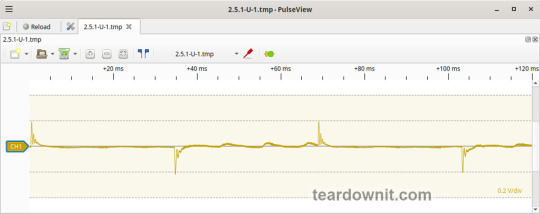
The supply’s response to load changes is a bit shaky. The magnitude of the response to load changes reaches 200 mV.
Overload protection
The claimed protection type is "hiccup mode, which recovers automatically after the fault condition is removed." This was confirmed during testing. When a short circuit occurs, the power supply periodically tries to turn back on and, if the overload is still present, turns off again until the next attempt. This operating mode reduces energy losses and heating during overload. Still, it does not allow the parallel connection of multiple power supplies with a common output.
The output current for the overload protection to kick in is 5 A.
Input circuit safety assessment
(Input discharge) Safety assessment is based on the discharge time constant of the input circuits when disconnected from the grid; the value is 0.234 s. This means that when operating on a 120 V input voltage, the time required to discharge the input circuits to safe values (<42 V) will be 0.37 s:

Important: The result is valid for this particular power supply unit; it was obtained for testing purposes and should not be taken as a safety guarantee.

The leakage current at the ground pin is about 11 µA.
Thermal conditions
When operating with no load connected, no component overheating had been noticed. Thermograms were captured at three power levels: 80, 90, and 100%, fully assembled and with the lid removed. Thermal images show that the most loaded element of the block is the input thermistor (NTC), and its heating seriously stands out against the background of all the other components. At 80% load, it heats up to 197F (92C, 117F above ambient temperature). At 90%, it's 214F (101C, 134F above ambient), and at 100%, it reaches 227F (108C, 147F above ambient).
80% load
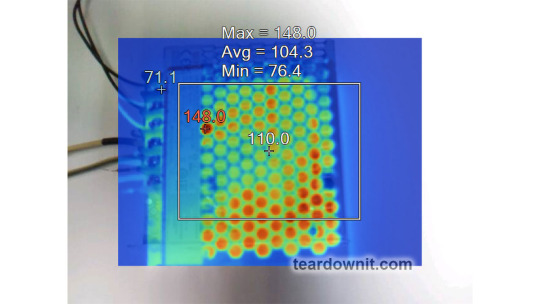

90% load
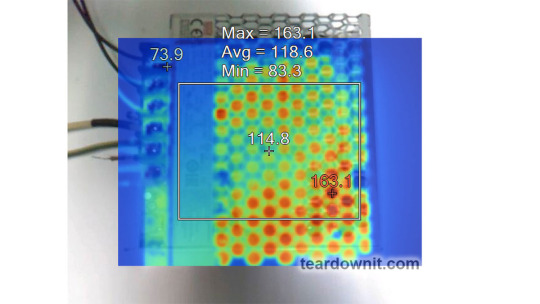
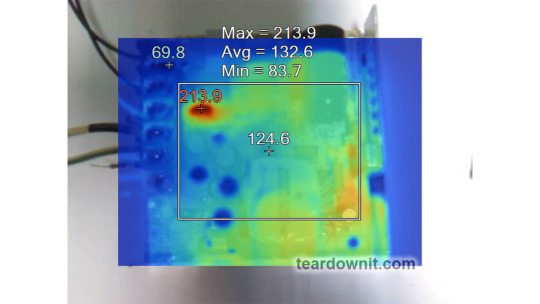
100% load
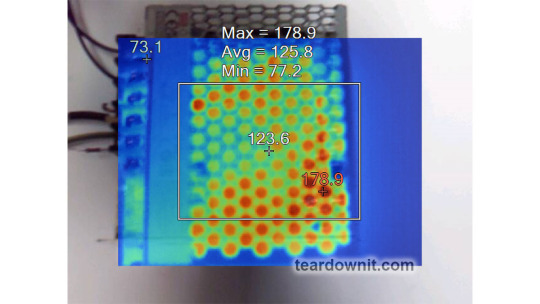
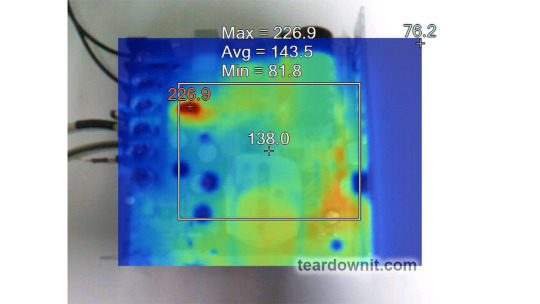
Conclusions
Overall, the LRS-75-24 is a solid unit. It's noise and ripple are acceptable for many applications, the output voltage is maintained accurately, and the build quality is decent. However, the dynamic characteristics of this power supply are not that good. When load pulses, one can notice large surges and quite some ripple, indicating some circuit design downsides in terms of its frequency characteristics. For long-term operation, the load should be limited to 80–90% of the nominal one, especially during the hot season when ambient temperatures reach 95F (35C) or more.
Important: The results are valid for this particular power supply unit; they were obtained for testing purposes and should not be used to evaluate all the units of the same type.
0 notes
Text
Siemens 6GK5980-1DB10-0AA5 4-pole Spring-loaded terminal block
Siemens 6GK5980-1DB10-0AA5 4-pole Spring-loaded terminal block for power supply (24 V DC); for SCALANCE X/W/S/M; 1 pack=5 units spare part. Model: 6GK5980-1DB10-0AA5Categories: Industrial EthernetBrand: SiemensSiemens 6GK59801DB100AA5 4-pole Spring-loaded terminal blockSiemens 6GK5980-1DB10-0AA5 4-pole Spring-loaded terminal block 100% New & Original. Quick Quote. Fast Delivery. Competitive…

View On WordPress
0 notes
Text
Punch down Tools
When terminating or connecting links to punch-down blocks, patch panels, or keystone jacks in the framework of telecommunications and network infrastructure, a punch-down tool is a portable tool that is utilized. Establishing dependable and long-lasting connections between wires and connectors is the main function of a punch-down tool.
There are different types of punch-down tools, including impact and non-impact versions:
Impact Punchdown Tool
The more popular variety is the impact punch-down tool. It contains a spring-loaded instrument that maintains an effective connection by exerting force on the wire when pressed down. For larger installations, this type is more effective and faster.

Non-impact Punchdown tool
The non-impact punch-down tool is free of a spring-loaded mechanism. Instead, the force is utilized manually through the user to set up the link. Smaller installations or circumstances in which greater control over the termination procedure is required are common uses for this kind.

0 notes
Text
HYPER-DURABLE CARBON FIBER WALLET WILL MAKE YOU DITCH THAT TERRIBLY OLD LEATHER BI-FOLD
HYPER-DURABLE CARBON FIBER WALLET WILL MAKE YOU DITCH THAT TERRIBLY OLD LEATHER BI-FOLD
There was a time when “money” meant physical valuables. Belongings, jewelry, and coins made of precious materials like gold or silver. In this pre-cash era, it made sense to use a leather pouch to carry your items. As we moved to banknotes as currency, the flexible leather bifold wallet still made sense. BUT… we’re now 250 years past the Industrial Revolution, so why are we somehow still clinging to this prehistoric ancient material for making our wallets?Get more news about Men's Wallet Carbon Fiber,you can vist our website!
A dominant part of our financial institutions are now online, with more people using cards to make payments than actual banknotes and coins. This transition also demands a cognitive shift in the definition of what a wallet should be… and what it should look like. The Masverano Wallet is a part of that global movement towards a new future with a better wallet. Crafted from carbon fiber with a durable plastic chassis underneath, the Masverano hopes to be everything you’d expect from a wallet of the future. It’s sleek-looking, strong, spacious, lightweight, functional, secure, and uncomplicated.
The Masverano wallet’s design is simply a modern classic. It isn’t ancient, like your leather or fabric bifold, it isn’t overtly complicated like some over-engineered modern-day wallets we see today. It cleverly holds your cards between two robust carbon fiber plates, blocking them from view as well as RFID-protecting them. Your cards stay concealed, as does your cash (unlike modern money clips), and you don’t really need to struggle with mechanized triggers and spring-loaded deployment systems that deploy your cards in a fan-shaped pattern. You’re a classy urban citizen, not a street magician.
The Masverano wallet’s simplistic approach is clearly visible in its design too. The wallet is broadly made of four parts – two high-quality 3K carbon fiber plates, a PA 66 plastic frame, and a silicone band holding the entire thing together. On the inside, it has space for as many as 8 credit cards or a combination of credit cards and business cards, and a crawl-space built into the plastic frame in the middle easily allows you to store banknotes, coins, or even a key inside. Your cash stays hidden inside the wallet, and can be accessed on command. Easy peasy.
The beauty of the Masverano lies in the fact that it draws a fine balance between being modern and traditional. It reinterprets the wallet’s design and function for modern times, but still functions somewhat like your standard wallet by opening like a book to reveal what’s inside. If you want to access your cards, you can either open the wallet and grab the card you need, or slide your thumb into the notch in the carbon fiber panel to push your cards out and pick one, or simply tap to use it at a payment terminal.
By virtue of its sandwiched design, your cards and cash get conveniently segregated. The cash sits right in the middle, fitting into the cutout in the plastic chassis, while your cards get divided by the chassis into two zones. You can either divide your cards based on how often or rarely you use them, or by the type of card, be it a payment card, an ID card, a public transport card, or a business card.
0 notes
Text
Carbon Brushes manufacturer
A carbon brush is a sliding contact that ensures spark-free commutation in DC devices by transmitting electrical current from a stationary to a rotating section of a motor or generator. A carbon brush may consist of one or more carbon blocks, as well as one or more terminals and shunts. The amount of power provided to the motor and how often it is used impact the carbon brush's lifespan. Carbon brush grades are separated into four groups based on production methods, carbon grades, and other components. The many brush kinds include those made of carbon graphite, electro graphite, graphite, and metal graphite.
Carbon Brushes manufacturer :
1- One-piece solid carbon brushes are the most fundamental type of brush and are used on machines with little to no electrical or mechanical issues.
2-Brushes for fractional horsepower (HP): These carbon brushes are also referred to as "spring-loaded" brushes due to the related spring that is used to load the carbon in the brush holder. Despite the fact that FHP brushes can be separated, the bulk of these applications are single pieces.
3-Split Carbon Brushes: By joining two, three, or more carbon sectors into a single piece, split brushes can achieve improved electrical and mechanical contact. The brush can be divided to create more electrical contacts between the brush surface and the commutator and to distribute pressure more evenly.

#carbon brush holder#carbon motor brush#carbon brush suppliers in delhi ncr#carbon brush manufacturer#carbon brush oprater#carbon brush
0 notes
Text
Our Copper Cable Lugs & Aluminium Cable Lugs
Copper Cable Lugs and Aluminium Cable Lugs are topped and loaded with oil to keep away from the oxidation of the aluminium and make a water-blocked association. Appropriate for high voltage link end.
The nonattendance of the review gap forestalls dampness entrance, making these “Aluminium Cable Lugs” and “Copper Cable Lugs” additionally reasonable for open-air applications. Pass on creasing positions are set apart along the Aluminium and Copper Lugs length to guarantee sheltered and solid link pleating of the connector.
Copper Cable Lugs & Aluminium Cable Lugs Types
We as Copper cable lug makers in the area of Aluminium Cable Lugs and Copper Cable Lugs from our company emerges as a preferred choice in the market. Enhanced service life and well tested design enable this product to grow from strength to strength.
We offer this product to our customers only after multiple quality checks and deliver the same with an excellent packaging. These are simple Copper Lugs which can be spliced into control lines. These Aluminium & Copper Cable Lugs are built utilizing best quality apparatus and by executing advance advances.
Our item accompanies different highlights, for example, dimensional precision, reason particular development, dependability and strength. These can be benefited at advertise driving rates.

Copper Cable Lugs and Aluminium Cable Lugs in Competitive Price
Copper Cable Lugs and Aluminium Cable Lugs are utilized to end the closures of battery link and welding link so they can be associated with other electrical gear, for example, starters, meld pieces, appropriation squares, and so forth.
Produced using unadulterated copper, link hauls are profoundly conductive and can deal with high streams. As the main firm, Pioneer Powers Internationals occupied with assembling, providing, exchanging and wholesaling Lugs. By utilizing the world-class aluminium and copper, we have built up our range as per the business standards.
These hauls are utilized as a part of numerous applications in electrical industry. we have outlined our item extend in such a way, to the point that it suits all the quality guidelines adequately.
What exactly are Copper Lugs?
Lugs made of copper:
Have you ever wondered what that silver gleaming metal at the end of your cables or between your wires is? It’s a Copper Lug, after all. They attach cables to electrical appliances, other cables, surfaces, or mechanisms using Copper Lugs, also known as cable lugs.
Copper lugs are commonly seen on the clamps that connect wires to an automotive battery, as well as on the ends of battery jumper cables. Copper lugs are commonly employed when permanent, direct-fastening methods are neither practical nor essential. They are designed to be quickly placed and removed for repairs or maintenance.
In order to prevent damage to copper lugs, cables, connectors, and short circuits, they may be covered with a protective coating. Copper lugs are appropriate for heavy gauge power demand or grounding applications. Each copper lug has the option of being crimped or soldered to wire. For an aesthetically pleasing finish, the copper lug has a burr-free look.
Depending on the type of lug, one end of the copper lug fits the cable through soldering, welding, or crimping. A bolt, screw, or spring clip is used to secure the other end of the copper lug to a matching termination or connecting point.
Application:
The Cable Lug connects a cable to the device while the other end is connected to the connection termination. To ensure a secure connection, the initial end is crimped, soldered, or welded. The second end is held together with a screw or bolt. The application of terminal and bimetallic lugs vary as per industry.
Cable lugs come in a variety of sizes, forms, and materials, as well as various configurations. Insulated lugs with various terminals, such as a pin, blade, hook, fork, and ring terminal, are required in the wiring, automation, control panel, and instrumentation industries.
For many connection needs, most devices are connected with copper ring-type lugs. Another form of the lug is the butt and parallel connector. These are used when two cables need to be terminated or linked.
Heat shrinkable, closed-end type, butt type, and PVC insulated are the most popular. Depending on the cable type, copper cable lugs can also be utilized as butts and parallel connectors.
On the off chance that you had any inquiry regarding our “Copper Cable Lugs and Aluminium Cable Lugs” at that point don’t hesitate to get in touch with us.
Do visit our site https://www.pioneerpowers.com/ for any further queries or else you may contact us via filling out the form given in contact us.
1 note
·
View note
Text
TAFAKKUR: Part 53
Why do we turn over during sleep?
Our skin is not only a means for our body to look nice esthetically, but it also acts as a shield against negative external effects. For instance, it helps protect us from mechanical and chemical injuries or rashes, harmful waves of sun, and virulent microbes. Even though millions of microorganisms inhabit the surface of our skin, they cannot easily cross that barrier. But when the skin is scratched, these microbes can reach deeper parts of the body, causing diseases. If investigated under a microscope, we see that skin is not a mere cover but also an organ in charge of important duties. That is to say, skin is a very important organ which helps us sense hot and cold, pleasure and pain, regulates body temperature by relaxing and constricting blood vessels. It terminates microbes via giant Langerhans cells, synthesizes vitamin D, heals of wounds, and removes toxins via perspiration.
Skin is composed of two main interwoven layers of dermis, on the inside, and epidermis, on the outside. The epidermis, which is composed of five sub units, possesses the most important sign of our identity. Each thin layer is arranged in a way to carry out different tasks. A significant amount of elasticity and flexibility is provided to skin via these five layers. These layers can glide on each other slightly and can also be compressed under pressure. They are compressed when we sit on a hard surface. This situation can be similar to the compression of the spring in a click pen, or the suspension of a vehicle under a load. They regain their previous state upon termination of the pressure, like standing up. This elasticity is crucial for skin’s integrity.
The thin construct of our skin contains sweat glands that are embedded in the fibrous connective tissue. There are sensory receptors, hair roots, and hair muscles connected to them, and also loose nerve endings, and a network of capillary vessels. Free nerve endings are created to specialize in various functions so as to sense hot, cold, pressure, and pain. Likewise, the continuation of blood flow relies on very intricate calculations that are hard to explain. When blood vessels arrive at the skin, they are dispersed like a net in the form of capillaries.
The blood pressure of the arteries located at lower section of the skin is higher than the pressure of pulmonary veins. If pressure is applied to skin for a long duration from outside, the pressure in the pulmonary veins builds up and regional blood flow is disrupted. Therefore oxygen, glucose, and other nutritional substances cannot be delivered to these areas; along with inhibition of waste product removal, it leads to a nutritional abnormality in the tissue.
Sensory cells within our skin detect and report nutritional abnormalities of tissue to our brain via various chemical substances (like acetylcholine, bradykinin, and histamine). Thus we change our position consciously or subconsciously with the intervention of our brain to avoid the danger of a nutritional abnormality, and therefore the area regains normal circulation. In this stage, the process is still reversible; however, should the pressure continue, skin cells will start to die from, from the outside in. These systems do work well in healthy persons but in cases of stroke or coma, the intervention system does not work.
This critical picture can be understood better with an example. Just like roads need to be used in order to carry goods and remove trash, the transportation of minerals, vitamins, and many other life saving substances to the distant parts of the body and removal of waste products requires blood vessels to remain open. This must continue in a perfect balance without any interruption throughout our lives.
If a pressure ulcer occurs, it is like being exposed to external dangers in a house if a door or window breaks. It is like a free entrance visa is granted to germs that were blocked. Our back and pointy areas, like, thighs knees, heels, and shoulders are under more pressure, and therefore at more risk when we lie down. Two to six hours of pressure to one of these areas is enough time to disrupt skin integrity. Our daily sleep requirement is around 6-8 hours, therefore we need to switch positions a couple of times during our sleep. Therefore we face this risk everyday in our sleep; however, thanks to the perfectly functioning protective systems, without noticing during our sleep, our position is changed and this dangerous situation is avoided. Intensive care doctors and staff know better what a great blessing that is are since intensive care patients are mostly unable to move. Despite the use of many preventive efforts, like turning the patients in certain periods or the use of air beds, pressure ulcers still occur and a significant portion of patients die of the microbial infections caused by these wounds.
The story of sleepers
“The Seven Sleepers” story in the Christian tradition is retold in the Qur’an as “the People of the Cave.” The story is about a group of young believers who took refuge in a cave fleeing the oppression of the pagan Roman emperor. Both traditions narrate that they fell asleep in the cave, where they stayed asleep for hundreds of years. The Qur’anic account, however, mentions that they were made to change position during their centuries-long sleep: “You would have thought them awake though they were asleep. We caused them to turn over to the right and the left…” (18:18). It is an interesting nuance that they were made to change position, for it sounds rather irrelevant to the rest of the story. However, with the medical conditions of our skin that were explained above, this nuance makes perfect sense as advice to us on how we should treat patients who are unable to move.
#islam#allah#quran#muslim#revert#god#help#ayat#convert#religion#muhammad#prophet#muslimah#hijab#dua#salah#prayer#reminder#pray#welcome to islam#how to convert to islam#new muslim#new revert#new convert#revert help#convert help#islam help#muslim help
6 notes
·
View notes
Text
Three Phase Line Is Efficient Than One Phase Line
Are you the person who is looking for the three phase line use?
If yes, this is guide for you.
By using three phases than one phase, what is going to happen is – You can manage to generate power as well as deliver more efficiency than one phase everlastingly.
Thus, do you want to take your projects on a higher level for efficiency and growth?
If this is what you are looking for, the one suggestion we have got is to increase the number of phase for more productivity and operation’s continuity.
P.S. Are you on your way to using Spring Loaded Terminal Blocks? Do you want a reliable, trustworthy as well as performing Spring Loaded Distributor Box? If this is the case with you, then it’s high time to get your way to http://www.elmex.net since they have got amazingly and qualitatively awesome Spring Loaded Terminal Blocks as well as Spring Loaded Distributor Box. The best part is – Spring Loaded Distributor Box is oftentimes used in higher phase lines than one phase line. It means – More power and efficiency in the operation! Do make sure you have the best supplier as well as distributor of the same. Along the lines, do contact the recommendation we have shared here!
As you have learned about three phase line as well as the use of Spring Loaded Distributor Box, it’s always suggested to approach the right supplier since this can make or break the deal.
On top of everything – If you want continuous performance in the industry and operation you are working where there’s an involvement of Three Phase Line than the one Phase line, you got to make sure to have Spring Loaded Distributor Box from http://www.elmex.net as its highly important, and they are known as the leading one for the same.
Do it right away and enjoy continuity in the operation, today.
Final Thoughts
To not make the blog post super technical, we have got it super simple with a recommendation to go through.
Do follow through and learn everything, and thanks for the read, though!
0 notes
Text
Siemens 6GK5980-0BB10-0AA5 2-pole Spring-loaded terminal block
Siemens 6GK5980-0BB10-0AA5 2-pole Spring-loaded terminal block for Signaling contact (24 V DC); for SCALANCE X/W/S/M; Power supply for XF-200BA; 1 pack=5 units; spare part. Model: 6GK5980-0BB10-0AA5Categories: Industrial EthernetBrand: SiemensSiemens 6GK59800BB100AA5 2-pole Spring-loaded terminal blockSiemens 6GK5980-0BB10-0AA5 2-pole Spring-loaded terminal block 100% New & Original. Quick Quote.…

View On WordPress
0 notes
Text
Boots Reads Homestuck Epilogue(s) Part 12 - Candy Page 18
==>
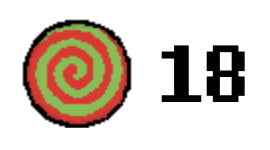
Time to see what all the fuss was about Page 18. We’re with Jane... that might not be good. Especially given Lollipop proximity.
Jane scoffing at troll genocide again. :(
Gamzee seems more woke than Jane here.
GAMZEE: sO yOu SaYiN yOu NeEd DiFfErEnT sHoEs FoR yOuR hUmAn DiCkS aNd WhAt NoT?
Pfffff
Jane narrows her eyes at the disingenuous buffoon.
I dunno, he sounds like he’s being pretty goddamn ingenuous right now.
It’s not the first time they’ve had this conversation? Are they black with each other or something??
What’s more likely is he’s attempting to get a rise from her. To get her a little hotter under the collar. To put her in a certain mood.
Oh my gosh she’s genuinely black for him, hahahahah
GAMZEE: AnD AlL I EvEr bEeN TrYiN To dO Is gEt yOu rIgHt tOo, WiTh mOrAlS AnD GoOdNeSs, AlL fIlLeD uP iNsIdE yOu As TiGhT aS yOuR tAsTy HoE bAlLoOnS aRe WiTh HuMaN mOo JuIcE.
Jesus christ that’s not the kind of metaphor i want to be hearing from canon
or anyone for that matter
JANE: No! I’d rather die than touch your disgusting clown baton ever again.
....yyyeah, context is showing she’s PROBABLY super Black into this. Still, pretty jarring to see a clear consensual “NO” right in the middle of things.
Quit calling her a dairy queen!!! D: D: D:
Oh god they named the baby Tavros.
Alright, there’s some grade A discomfort in this scene, which I’m enjoying, really. I can see why they singled out page 18. I could traumatize some people with some of these paragraphs out of context.
HOO HOO HOO, THIS LITTLE PIGGY WENT TO THE DARK CARNIVAL!!!
Eeeeuugh
JAKE: Anyway whats up with you? Hows life with davekat going? JADE: oh its great! im really glad i just went for it JADE: all of us together... it really is the best of every world
God damnit Jade why are you obliviously torturing them????????
You could’ve been REALLY GOOD for them both if you just FUCKING LISTENED TO THEM AND RESPECTED THEM INSTEAD OF SITTING ON THEM.
JADE: theres no way me and dave could have a regular baby together because im... JAKE: Whats wrong? JADE: well lets just say that after all the sburb stuff its done some things to my body JADE: like merging with bec mostly
Oh my FUCKING GOD please don’t canonize this. This didn’t need to be spelled out so-- D:
jesus
D: D: D:
This... is actually making my stomach roil again????
like
not because id object to-- i mean, it’s one thing to deal with
FAN SCENARIOS
ISOLATED divergences from canon where she has to deal with that and its kind of hilarious, but can be safely ignored when it comes to her character arc as a whole
but once its CANON???????? D: D: D:
suddenly you can’t IGNORE the full import when you’re done with, like, an RP or something, of the psychological struggle she would be forced to deal with given an abnormal biological situation. Instead of thinking “Oh, that could be pretty painful to deal with! Let’s explore it temporarily for fun” it becomes “Oh, that would be painful to deal with and you have to think about her having to deal with all the complications of that whenever you hear about her LITERALLY FOREVER.” D:
andrew i know you couldnt resist because of how funny and practically-xenoprogressive it was but whyyyyyyyyy did you have to canonize that WHYYYY
Now instead of a fun joke thought it also has to be SAD FOREVER
AAAAAAAA D’:
i dont know why this would be the line thats crossed to upset me
Rose surrogate?
JADE: no jake, dave wouldnt be the father in this scenario!
Pffffff. Andrew’s just diving RIGHT into the, er, doggy fanfics here. I should... TRY to lighten up about this. Try. D:
(...wait, shit. Knowing my friend, THIS whole bit is why they alluded to this page. God damnit.)
[[ EDIT: askshenhibiki said:
Now that you read Candy 18, flash back to Meat when Roxy is talking about gender... and look at Jade's reaction looking at "where her hands rest on her lap". Yes, Meat hinted at that "mix" too.
Ah, let’s see...
ROXY: and so i got to thinking ROXY: what even is gender ROXY: amirite lol? JADE: oh yeah JADE: that makes sense i guess........
Jade looks at where her hands are folded in her lap. Bites her lip. She has her own concerns about this, her own thoughts. Reasonable thoughts, I’d say. But I’ll refrain from any further comment. I’m staying away from this subject, from now on.
...yeah, guess Dirk at least had the decency not to spring all that on us before Jade got the opportunity to do it honestly. ]]
Guh, back to Jake suffering in his sad, trapped scenario. I hope THAT gets at least resolved by the end of this. Someone save Jake from this, because it looks like he’s not really that capable of saving himself?
==>
Dammit, Jade, I’m cringing at these descriptions of your intrusion.
Oh wow, John went for the mustache. Guess we knew that from, like, his stuffed statue oldself?
Jade doesn’t pick up on the obvious subtext in the conversation, however, because she’s been willfully undermining the subtext in her own personal life for nearly a year now.
D: D: D:
Seriously, Jade, how is what YOU’RE doing any better than what you were frustrated at seeing THEM doing, avoiding the real feelings and truth of anything even if it was conspicuously on body-language display?
KARKAT: THE NEW ADMINISTRATION IS CRACKING DOWN ON CERTAIN KINDS OF INTERSPECIES ADOPTION LAWS.
It’s like Andrew wants us deprived of even a happy imagined future for Earth C on top of everything else!!! What the hell! >:(
Is this about politics? Is Andrew just venting his anger that the Orange Guy is going to get away with ruining everything forever?? Because as understandable as that is, he could at least give us some imaginary happyfutures to look forward to.
Reading on... Hm, yet another intentionally-misused fridging reference.
KARKAT: HIS RELATIONSHIP IS A FLAMING WRECK OF AN INTERSTELLAR WARSHIP HURTLING TOWARDS THE PLANET AT TERMINAL VELOCITY WITH THE ENTIRE CREW BRUTALLY SLAUGHTERED UPON REENTRY, SHOVED STRAIGHT DOWN THE CHAGRIN TUNNEL AND THEN IMMEDIATELY SHAT OUT THE OTHER SIDE, THUS FLOODING THE ENTIRE FUCKING NEIGHBORHOOD WHEN IT CLOGS UP THE LOAD GAPER.
Yep, that triangle’s fucked. Wonder if the conversation’s going to transition to the CURRENT triangle’s problems...
...yeah, John using the R word there isn’t far from the fucking truth from the looks of things.
JADE: maybe that would work for a few days, but one thing i learned from dating around a lot in my youth is that no ones going to leave a bad relationship until its THEIR idea to leave
She takes in a shaky breath and shuts her eyes. Her hair spills around her face when she leans forward to put her chin on her knees. Dave and Karkat exchange a look that is equal parts confused, miserable, and desperate.
Oh SHIT. Is JADE going to be the one to finally vocalize about the problems here???
Something else comes hurtling out of the hole in the sky, too fast for Jade to catch. It hits the ground with a clap of green lightning. The collision sends a geyser of dirt, rock, and vapor into the air. Dave flash-steps to shield Karkat. Jade doesn’t move, taking the brunt of the explosion face on, using her abilities to warp the energy around her so that she’s a mote at the center of the storm. When the dust clears, she’s the first to jump in the crater, trailing smoke behind her.
There’s a body at the center of it. The torso is bloody, tangled, and curled into a fetal position. Its shoes are missing, but otherwise the outfit is quite familiar to her: it’s a dead ringer for her old Witch of Space uniform. Jade touches the body with the toe of her shoe, and then gasps when it rolls over to reveal its face.
JADE: its... JADE: ME???
Okay what the FUCK. It sounds like there’s going to be some context for that postscript after all. Something to bridge the gap between when that 16-yo Jade falls into the singularity and when Aradia goes off with her through a wormhole
I’m going to guess up front that this happens BEFORE the postscript... this younger version of Jade fell into the black hole and came out in THIS alternate timeline, possibly rather changed by the experience. But then again, the way the sky opened up... actually, couldn’t that be just a “natural” manifestation of the black hole abilities encouraged by Calliope or done by the singularity alone, followed by later in the Postscript this Jade actually getting control of it??
And... reading on, from the sound of it, her eyes aren’t black yet, either. Sounds like that’s to come, before the postscript. Question being, is it alt!Callie black eyes, or some black-hole-powers visual manifestation? Wait, never mind, I misread; this teenage Jade-corpse has NOT opened their eyes yet, so they couldn’t possibly tell, and the stuff about them “shaking” was about the adult Jade standing over her. Never mind. Let’s see which timeframe this Jade came from.
Also STOP TRAUMATIZING ADULT JADE ON SCREEN ITS NOT OKAY IM SICK OF IT ANDREW
==>
Page 20...
Stop letting babby not!Vriska bully babby not!Tavros.
Hm... same stupid tooth poison? No, Jade didn’t get hit with a tooth... so it’s more getting hit with shards of spacetime and spiraling down a black hole. Also whatever alt!Callie did to just barely keep her alive.
Hm, so the Heart stuff falls apart if you’re too separated from the mass-whole at Light’s center? That’s certainly a hypothesis at least.
ROXY: sounds like its time for another funeral lmao
ROXY WAKE THE FUCK UP AND STOP BEING A VAGUELY ROXY-LOOKING LMAO-ZOMBIE. WHERE THE FUCK DID REAL ROXY GO.
And where the fuck is Calliope anyway, she’s just being left in the dust and nobody’s even talked to her from the looks of it.
Hm, cut apart by political differences, this group...?
ROXY: woah ok karkat i get ur all fired up about politics and stuff but lay off gamz ok
ROXY WHO REPLACED YOUR FUCKING BRAIN WITH A BLOCK OF CHEESE
ROXY YOU’RE MY FAVORITE CHARACTER PLEASE GIVE US AN EXPLANATION FOR WHY YOU’RE ACTING NOTHING LIKE THE COOL SMART PERSON WE READ ABOUT.
JADE: dave what the FUCK did you say to him downstairs?
Oh my god you asshole don’t blame DAVE for this >:(
ROXY: this time next week well corpse party like its the end of the world!
I don’t want to think this has anything to do with Aradia, but we DID see her in that postscript bit... And, I mean, what the hell could she even do?? It’s not like this Roxy is just Aradia in really convincing cosplay or something.
==>
She leads John and Jake into the building and down the center of the nave, humming happily to herself the entire time. An equally effusive Calliope trails behind her, carrying a bouquet of purple flowers.
Well there’s Callie. What is WITH these hypnotized motherfuckers. I need a revelation on these shenanigans STAT.
What is with people being bathed in light here?
each time we witness death, we fall in love in with the important people in oUr lives all over again.
Calliope is gazing at Roxy with glassy eyes. She sniffs as she plucks the last petal from her rose. A breeze washes through the cathedral from the crack in the door at the end of the room, brushing the petal off-course and causing it to get stuck in Roxy’s over-sprayed hair. Calliope reaches out with a visibly shaking hand to remove the plant offal, but she does not draw back. Instead, she lets her hand graze down the side of Roxy’s face and cup her cheek. Roxy puts her own hand over Callie’s and holds it.
Uhhh.... huh.
So.
If Roxy was just lying to herself, then............ WHY??????
John tilts his head and squints at the image in front of him. Hmm.
Is John realizing he’s in some sort of fanfic drawn by another character, hence all the people in serene lightbeams at tender but unjustified moments?
Everyone whips their heads around to see, of all people, Aradia hovering in the foyer
Pff
(...I hope Aradia didn’t come here, like, from the postscript. Where the “action” she talked about might have just been this corpse party. Because that would be pretty fucking lame.)
KARKAT: MAYBE FUCKING NEPETA IS ABOUT TO POUNCE FROM BEHIND THAT GROTESQUE STATUE OF THE HUMAN SUFFERER T-POSING OVER THERE.
Pfffffffffff
The description of Human Jesus we all had in our hearts, but were too afraid to voice.
Alright, now we see the body we took our eyes off of. Is it going to get back up, or did it escape earlier?
since nobody was willing to dislodge the huge, otherworldly shard from her chest
My damn god, people.
...alright finally, everyone’s talking.
JANE: Agreed. I’ve always felt that Kanaya has done an exemplary job of providing a model for compassionate, empathetic behavior, which others of her kind would do well to follow.
JANE STOP BEING A XENOPHOBIC BASTARD
CALLIOPE: please. roxy gathered yoU all here for a reason. CALLIOPE: at least listen Until the end. CALLIOPE: after that yoU can argUe all you want.
...Huh. Huuuuhh. What the fuck is all this for. Are you saying ROXY caused this? Or...?
Okay I like this reinforcement she’s making in her speech about how different changes can influence how all of this unfolds, gives me hope that maybe these two cliffhangers aren’t all we’re going to be left with and we’ll be able to at least think of an IMPLIED future different from them if we wanted to like we thought about the seemingly-infinite-possibility original ending of Homestuck that I’d rather have been stuck with than this oh god breathe boots
okay there’s the labor going into good distraction
alright corpse get back up
JADE: i am not jade.
Right, so like the black eyes in the postscript suggested this is more just a... vessel for alt!Calliope now? To give HER a future beyond the one she sacrificed for that black hole business? And between alt!Callie’s became-the-black-hole nature and Jade’s Spacey Green Sun connection that’s been singularified, she has access to cool Black Hole powers? And is gonna do cool shit with them in implied future adventures we won’t see while Aradia gleefully watches the carnage? Huh.
The congregation watches her go, but no one moves to help her, or even looks in her direction. In her wake, she leaves a primal, echoing wail.
Oh my god why wouldn’t they have just a brief discussion or something IT’S NOT THAT BAD D:
JADE: and while i cannot say the same thing for the rest of you, JADE: i, at least, am exactly where i am meant to be.
Well fuck. So she just disconfirmed this timeline as... something. Relevant, possible, I dunno.
JADE: and i have entered this body to protect your world.
Okay that’s good. So thanks to alt!Calliope these side timelines where things unfolded differently MAY be preserved. Pretty fitting given alt!Callie’s origins.
.......unless there’s some other stupid interspecies civil war threat that she’s going to be fighting too, here, when the political situation falls apart. Dammit.
==>
Terezi talk Terezi talk
-- JOHN EGBERT sent TEREZI PYROPE the photo “ghostrain.jpg” --
TEREZI: WH4T TH3 4CTU4L FUCK JOHN: it started a few days ago. the sky above the capital of the troll kingdom just cracked open and ghosts began raining down everywhere.
Oh my GOD. So alt!Callie kind of “saved” all the doomed ghosts that got swallowed up in the black hole by redirecting them all to THIS UNIVERSE and timeline???????
That’s pretty interesting! Heck my stomach’s even calming down!
they can’t even be judges! TEREZI: G4SP
Yeah that’s pretty terrible!
...yep, the resistance WOULD put him in charge. I had a feeling it may have ended up in that direction in Candy since it wasn’t in Meat.
--oh FUCK YOU Jade for splitting up what he had with Karkat before they could sort it out!!! You did the OPPOSITE OF HELP and neither of them are going to end up happy thanks to you! D:<
PFFF wow, John’s so concerned about babby not!Tavros’s living situation that he’s considering legit kidnapping. That means things must be pretty fucking bad.
--okay Calliope’s still out and about with Roxy instead of being cooped up in her room like in the other timeline, that’s good.
Pff, trying to redeem Ghost Eridan in front of Ghost Feferi. Yep, that’s Gamzee.
GAMZEE: fIrSt, A LiTtLe RiGhTeOuS sPlAsH oF tHe NaNnA nEcTaR tO cLeAnSe ThAt DaNkNeSs FrOm YoUr SoUlS...
Gamzee takes out a baby bottle and flicks it, covering them both with little drops of milk, as clergy does with holy water. He then takes a swig from the bottle himself before returning it to his codpiece.
Jesus. Fucking. Christ.
I don’t want to believe that what’s in that bottle is what he’s making it sound like it is, but OF COURSE it is. Why would it be anything else. I bet there’s not even any Lifey hypnosis going on, it’s just the literal stuff.
The crowd falls silent as they raise their heads to watch a drone ship pass by overhead.
Jegus fuck stop going whole hog condesce janey
ROXY: lmao you worry too much ROXY: janeys got her head on straight shell show you yet
ROXY. WHERE DID YOUR BRAIN GO. I MISS IT. YOUR BRAIN WAS THE BEST FUCKING PART OF YOU.
Touching photo.
Alright lemme post split. I haven’t gotten as far as the last post plowed through since I’ve been typing so much... ah well.
26 notes
·
View notes
Photo

Last week (July 2017 -Prat) a Trump administration official decided to inform the news media that the CIA program to arm and train anti-Assad Syrian forces had been terminated. It was welcome news amid a deepening U.S. military commitment reflecting the intention to remain in the country for years to come. As my recent article in TAC documented, the net result of the program since late 2011 has been to provide arms to al Qaeda terrorists and their jihadist and other extremist allies, which had rapidly come to dominate the military effort against the Assad regime.
The Trump administration’s decision to acknowledge explicitly its decision to end the program invites a more systematic analysis of why and how such a program, which was so clearly undermining a fundamental U.S. national-security interest, could have gotten started and continue for so long. The preliminary version of the program that began in late 2011 is easier to explain than its more direct form two years later, which had continued (at least formally) until now.
One of the keys to understanding its origins is that the program was launched not because of a threat to U.S. security, but because of a perceived opportunity. That is always a danger sign, prompting powerful national-security bureaucrats to begin thinking about a “win” for the United States. (Think Vietnam and Iraq.)
The opportunity in this case was the rise of opposition protests against the Assad regime in spring 2011 and the belief among national security officials that Assad could not survive. The national-security team saw a shortcut to the goal. Former Obama administration official Derek Chollet recalled in his book The Long Game that Obama’s advisers were all talking about a “managed transition” and urging Obama to publicly demand that Assad step down, according to Chollet. What that meant to Obama’s advisers was bringing pressure from outside, including providing arms to the opposition.
That was wishful thinking not only in regard to the willingness of an Alawite-dominated regime to hand over power to its sectarian foes, but in regard to the assumed Iranian willingness to go along with toppling the regime. Not one of Obama’s advisers had sufficient understanding of regional dynamics to warn the President that Iran would not allow their Syrian ally to be overthrown by an opposition supported by Sunni states and the United States.
But the decisive factor in pushing the administration toward action was the pressure from U.S. Sunni allies in the region—Turkey, Saudi Arabia and Qatar—which began in autumn 2011 to press Obama to help build and equip an opposition army. Turkey was the leader in this regard, calling for Washington to agree to provide heavy weaponry—including anti-aircraft and anti-tank missiles—to the rebel troops that didn’t even exist yet, and even offering to invade Syria to overthrow the regime if the U.S. would guarantee air cover.
In the ideology of the national security elite—especially its Democratic wing—regional alliances are essential building blocks of what is styled as the U.S.-sponsored global “rules-based order.” In practice, however, they have served as instruments for the advancement of the power and prestige of the national security bureaucracies themselves. The payoffs of U.S. alliances in the Middle East have centered on the military bases in Turkey, Saudi Arabia, and Qatar that allow the Pentagon and the military brass to plan and execute military operations that guarantee extraordinary levels of military spending. But enormous Saudi arms purchases and the financing of any covert operations the CIA doesn’t wish to acknowledge to Congress have long been prime benefits for those powerful organizations and their senior officials.
Then CIA Director David Petraeus was particularly interested in ginning up a covert operation to arm and train the Syrian opposition. With the security bureaucracies supporting the allies’ desire to unseat Assad, Hillary Clinton, whose sympathies and political strategy always lay with the war, eagerly took the lead to take the lead in the administration on arming the rebels and calling for a “no fly zone,” which the Turks badly wanted.
Despite this set of interrelated factors pulling the administration toward a policy of regime change, Obama said no to heavy weapons, a no-fly zone, and an official U.S. role in arms supply. What he did agree to, however, was a covert CIA operation designed by Petraeus to load weapons from Libyan government stocks in Benghazi on ships and arrange for them to be shipped to the war zone. It was Obama’s way of placating all of the actors pushing for an aggressive policy of regime change in Syria without being publicly committed to regime change.
That program, which began in October 2011, was halted abruptly by the attack on the embassy annex in September 2012. But by that time the Obama administration already knew that the weapons were falling into the hands of al Qaeda’s Syrian franchise al Nusra Front, as administration official revealed to the New York Times. Meanwhile the Saudis, Turks and Qataris were pushing arms to groups with military arrangements with al Qaeda’s al Nusra Front at a feverish pace, and the Saudis had begun making deals in Eastern Europe for the heavy weapons, clearly intending to equip a large conventional army.
The danger signals of a policy gone horribly wrong could hardly have been clearer. But at that moment in the summer and fall of 2012, Clinton and Petraeus began a new push for the CIA taking on the role of arming its own hand-picked “moderate” groups. Clinton argued in a White House meeting that the United States needed to have “skin in the game” in order to persuade its Sunni allies to steer weapons away from the terrorists.
But Obama fended off that proposal, citing the blowback from the U.S. Afghanistan adventure. While the debate continued in late 2012 and early 2013, the CIA did a series of studies—evidently ordered by the White House—of past efforts to build up insurgent armies from scratch. The conclusions were not encouraging, as someone defending Obama’s position in the debate leaked to the Times.
But then in early December 2012, Obama made a fatal political error: He introduced a “red line”—the use of a chemical weapon in Syria. Sure enough, within weeks the first rebel allegation of a regime sarin attack was made in Homs. And although the Obama administration quickly investigated and found that it involved tear gas, it was soon followed by a series of new claims of regime chemical attacks in March and April 2013, in which the evidence was very murky at best.
Of course Obama’s national security team, in concert with the Sunni allies, pounced on the opportunity to push even harder for a new U.S. program of direct military aid to the “moderates.�� Obama sought to avoid being sucked deeper into the Syria conflict; the administration even got the intelligence community to issue an unusually inconclusive intelligence finding on the alleged chemical weapons attacks in late April.
But for a second time, Obama also agreed to a CIA program of helping to arm the anti-Assad forces; it was a way of placating his own national security apparatus and U.S. allies while avoiding an open commitment to the war. And when nothing happened in the secret program for weeks, Obama’s national security team used an alleged crisis in the war to tighten the pressure on him to move more decisively. Secretary of State John Kerry and unhappy CIA officials arranged for a rebel commander to call into a White House meeting with the claim that Syrian and Hezbollah forces were threatening to bring about the collapse of the entire anti-Assad war.
Kerry warned that Obama would be blamed by U.S. allies for the outcome and proposed missile strikes on Assad’s forces. Within days, the White House ordered a new intelligence assessment that expressed “high confidence” that the Syrian regime had used sarin repeatedly and immediately made its conclusion public. And simultaneously the White House announced publicly for the first time that the U.S. would provide direct assistance to the opposition and leaked it to the Times that it would involve military assistance.
So at the very moment when Washington should have been exerting pressure on its allies to stop pouring arms into an anti-Assad war that was systematically building up al Qaeda’s power and influence in the country, the Obama administration was caving in to those allies. The reason was simple: Powerful national security bureaucracies were threatening to blame Obama for the failure of their heroic effort to save the anti-Assad war.
The lesson of the entire affair is clear: A malignant alliance between powerful national security bureaucracies and the Middle Eastern allies with whom they enjoy mutually profitable relations are pressuring the White House to approve actions that threaten the real interests of the American people—including strengthening terrorists. The only way to reverse that situation is to direct public attention to that malignant alliance of interests, which has thus far gotten a free ride.
9 notes
·
View notes
Text
The Kingdom of Rychilla - An Overview
The Kingdom of Rychilla is a mostly agrarian society, with farms radiating outwards from most of the towns. Most of the rest of the kingdom is covered by forests, and a network of rivers runs across it. The kingdom is roughly in the shape of a triangle, with a coastline running north-to-south. The south-west border is marked by the Druhlash mountains, occupied by the Druhlac. The north-west border is where the kingom meets the Raron Desert.
The kingdom is currently going through the Age of Magic. Elemental magic was discovered about a century ago and since then, it's driven the development of Rychillan technology. At present, it can best be described as 'steampunk magitech'. Fire and water type magic are used to generate steam, which powers piston as per a steam engine from our world. Energy for magic comes from crystals, which start opaque and become more translucent as the energy in them is used up. There are five elements, each with a corresponding colour of crystal:
Fire (orange)
Water (blue)
Ground (brown)
Air (white/cream)
Flora (khaki-green)
In order to be able to use the energy from within the crystals, humans (i.e. Rychillans and Druhlac) need to have skin contact with it. As such, the jewellery they wear (necklaces, bracelets, rings) is designed to hold crystals in contact with their skin. This jewellery also has clasps and catches in it, to allow the crystals to be swapped out.
For fairies, they just need to have the crystals near their skin. As such, they usually wear their crystals in their belt buckle, again with clasps and whatnot to release it. Fairies always wear a belt.
Steam engines are usually used to power larger vehicles, like cars, ships and airships. Smaller devices usually use a wound spring and clockwork.
Most of the action in my stories takes place in the town of Alkentoft. It's a major trade port, nestled on the east coast of the kingdom at the foot of the Druhlash mountains. Most of the structures are only one or two levels, and are made of bricks. There's no mortar, instead the bricks are fused together using groundkind magic.
Notable locations include:
The airship terminal, which is 8 stories high. It's got a two-level hall at the base of it, then three spires which stick up into the sky. Airships moor at these spires, and the passengers climb a spiral staircase inside them to reach the airships and board them.
The town hall. This is the second-largest structure in Alkentoft, after the airship terminal. It has three levels of offices, then a dome makes up the fourth level. This dome has windows running all around it, and is the office of the Steward. He's the regional governor, and Alkentoft is the regional capital.
The harbour, which is where goods and produce are loaded onto ships to be sent east.
The temple. This is devoted to the goddess Luxanke the Provider, who is worshipped by the Rychillans. It's an octagonal building, with 8 altars inside.
Like all Rychillan towns, Alkentoft has cobblestone streets, with cobblestone roads joining it to neighbouring towns through the forest and countryside.
***
The People
There are three main races who can be seen in Alkentoft. There's the Rychillans, Fairies, and Druhlac. The latter live in the Druhlash mountains, and visit Rychilla to trade.
Rychillans
The Rychillans are the humans who live in the Kingdom of Rychilla. They're pretty close to the humans of our world, and usually stand between 5-6 feet tall. Their gene pool is slightly different to ours, with medium-grey, brown and navy-blue hair and brown, grey and purple eyes naturally occurring.
Their fashion is steampunk-esque in design.
Law enforcement is done by the Town Guard, who are essentially the same as police constables on Earth. Serious crimes are investigated by veritors, who are roughly the same as police inspectors. They also worked their way up the ranks of the town guard before being made a veritor. They're charged with 'investigating threats to the peace of the kingdom of Rychilla'. Guard uniforms are maroon, which is the Rychillan royal colour.
Rychillan weapons are usually daggers or crossbows (no long swords).
Fairies
Fairies were the original inhabitants of the region covered by the Kingdom of Rychilla, back when it was all forest. They live in villages amongst the trees, with huts built amongst the branches and off the trunks. Rope-and-board walkways run between them.
Things weren't always amicable between the fairies and the Rychillans. However, that changed during the Druhlac occupation of the west-south-west corner of the kingdom. The Rychillans and Fairies joined forces to drive the Druhlac invaders back to the mountains whence they came. Following this, the Accord of Reiksoft was signed, between the Rychillans and the Fairies. This set out which areas of the forest were off-limits to humans, how much could be harvested from the forest, etc. This led to cordial relations between the humans and the fairies.
Up until this point, the Rychillans had avoided building in parts of the forest where fairy villages were located. The Accord of Reiksoft allowed them to build around fairy villages in the forest. So in all but the smallest towns, there's at least one 'block' amongst the buildings which is a section of forest, surrounded on all four sides by cobblestone streets. Each of these blocks has a fairy village in it. There are three such villages in Alkentoft.
This led to two different fairy subcultures developing. The forest fairies pretty much stayed the same, but the town fairies started to pick up elements of Rychillan culture. These days, most town fairies are employed by Fairy Postmasters, and work as messengers carrying notes and small packages around town (in pouches slung around them). They wear clothes that are close to Rychillan in design, as well as aviator goggles to protect their eyes while flying around.
Forest fairies, on the other hand, wear clothes woven from leafs and other plant materials, with no goggles. They generally act as custodians and protectors of the forest.
All fairies are vegetarian, out of necessity. Eating meat makes them ill.
Physically speaking, fairies are around 1/6 the size of humans, and usually stand around 1 foot tall. Their wings have the same shape as those of a butterfly. Their wing colour varies, depending on which part of the forest they're from. They also live to be around 200 years old.
Fairy weapons are usually small daggers (known as 'stingers'), bow-and-arrows and crossbows.
Druhlac
The Druhlac are a race of hunters and miners, who live up in the Druhlash mountains. There's not much land for farming up there, so they can only really eat what they can hunt and forage for. This is what drove some Druhlac tribes to occupy part of the Kingdom of Rychilla. After they were driven back to the mountains, they decided to do what the non-invading tribes were already doing. That is, trading with the Rychillans.
They do have something the Rychillans want. Namely, the crystals used for the elemental magic. These are mined from within the mountains. There are some Rychillan mines in the foothills, but these can't supply the whole kingdom. As such, Druhlac traders frequently visit Alkentoft.
They are humans, but with a few differences to Rychillans. Druhlac usually stand between 6 feet and 4 inches and 6 feet 8 inches, with 6 feet 6 inches being the average height. Their skin is mottled, to help them blend in amongst the leaves and plants of the forest while they're hunting. Their bodies are more muscular than those of the average human. Not to bodybuilder levels, but what you'd see on a pro athlete. They have two horns, one on either side of their head. These emerge just above and behind their ears, go straight out for about 1 inch, then turn 90 degrees and point backwards horizontally. The point of them is level with the back of their skull. These horns are dark cream in colour, and smooth. They act to help amplify the Druhlac's natural hearing, especially in relation to things happening behind them - they pick up sound waves in the air and transmit them through the skull to the ear bones. Their hair is either brown or black, eyes are either brown or hazel.
Druhlac weapons are usually daggers, bow-and-arrow and spears. The latter were originally hand-thrown, but these days they're launched from a variation on a crossbow. They're mainly used for hunting.
15 notes
·
View notes
Text
Lift Parts Suppliers
Lift parts suppliers - Find the best components manufacturers
Lift Parts Suppliers
We are a leading supplier of high-quality lift equipment for use in the modernization of existing lifts and new lift design. We are the UK agents for some of the world’s most recognized brand names such as LiftEquip, SCHAEFER, Cobianchi, Hans Jungblut, Switch, and MGTI. The World's leading one-stop lift parts suppliers for all elevator & escalator spare (replacement) parts over many years of experience in the elevator industry.
Whether you have your mechanic who can handle the repair or you are hiring someone from outside, they should be able to offer you sound advice regarding what supplier to buy your spare parts from and what type of elements you should choose. No matter what kind of elevator you may have, it is always worth investing in high-quality parts.
Our central aim is to offer a quality partnership. Technical appreciation, flexibility, and innovation are pre-requisites of that relationship.
Lift Parts Suppliers
Quality engineering and customer support are critical features of the J&L Elevator Components commitment. Our extensive range of LiftEquip machines, together with the SCHAEFER range of pushbutton fixtures provide the complete modernization solution. We also can offer a unique solution to our customers by delivering multi-brand lift spare parts sales of a genuine manufacturer’s elevator and escalator parts.
We are a trusted training provider that delivers specialist assessment and training services to our Lift Engineering Division. The team is highly knowledgeable and supportive of our apprentices and other learners. They give us confidence within this challenging engineering sector.
The mission of our company –
To Provide Quality Elevators and Escalators at a competitive price.
To provide efficient and fast after sales service.
To achieve close product customization.
Our modernization kits designed to your individual needs are pre-wired, plug and play solutions that make a lift modernization more like a new lift installation. Lift parts suppliers help you build elevator & escalator parts procurement for your lift maintenance and manufacturing business by creating a professional one-stop service which best suits your needs and target audience.
Working closely with our customers, suppliers, architects, designers, and consultants, we aim to be the leader in our field, a company that as well as supplying elevator components, is making a difference by providing the best technical solution available.
If you would like any further information on any of the products we are always here to help,
Products
Geared Machines --> TW 45 C
TW 45 C is ideal for standard Geared Lifts. TW 45 C capacity is up to 1000 kg. Depending on your space requirements, you can obtain the TW 45 C with a vertical or horizontal motor position. The TW 45 C is available as a left-hand version with the option of a right-hand version when the motor is in an upright position.
The Geared Machines are designed with VVVF Motors in B5 Configuration with a flexible coupling, ensuring smooth, quiet running.
The TW 45 C is available with Speeds of 0.4 – 1.25 m/s and 1:1/2:1 suspension.
The Emergency Braking System (NBS) is optional on the TW 45 C. With the single circuit spring operated disc brake, it permits upward braking and complies with EN 81-1/9.10.
Products
Gearless Machines --> PMC 145
The synchronous Gearless PMC 145 XS-XL range are some of the world’s most compact, energy efficient Gearless Machines. The PMC 145 XS-XL have excellent efficiencies with more than 180 s/h and 50% duty cycle, suitable for Speeds up to 1.6 m/s and Loads of 1000 kg.
The range is especially suited for lifts with 2:1 suspension.
The PMC can be used in both the Shaft (MRL) and the Machine Room.
A Type Tested Safety Brake is used on all of our Gearless Machines, by EN 81-1/9.10.
Optional matching Frequency Inverter (MFC/MFR) can be supplied with the PMC 145 XS-XL, which feature all the drive parameters required. We provide many different lift parts suppliers to support for many of the world's elevator brands.
Products
MRL Sets --> LEA Standard
In some applications, LEA Standard has a lower headroom and smaller pit depth requirements than many other MRL’s. Space saved offers building owners, planners, and architects a much smoother planning process.
The LEA Standard passenger elevator is an impressive revolutionary solution that utilizes proven, high-quality equipment making it one of the most efficient MRL’s of its type on the market today.
LEA Standard is configured for the Rated Loads 450 / 630 / 1000 kg with Speeds 1.0m/s and up to 40m Travel Height.
The LEA Standard offers not only numerous equipment features but also options such as reduced safety spaced in the shaft headroom and the shaft pit.
Products
Lift Spare Parts --> Lift Components
We can offer a unique solution to our customers by providing Multi Brand Spare Parts Sales of a genuine manufacturer’s elevator and escalator parts.
Our Spare Parts portfolio is extensive, with us having 1,000’s of genuine manufacturer’s elevator and escalator parts from over 20 international brands including Otis, Selcom, KONE, Schindler, and ThyssenKrupp.
If you can’t find the part you require in the catalog, then all we need is the Part Number and a Photograph to help us identify it for you.
Products
Safety Gears --> PC11
The Cobianchi PC11 Safety Gear is available for use in the Upwards, Downwards, and Bi-Direction.
Suitable for P+Q of up to 1500 kg and Tripping Speed of 2.16 m/s.
For use in both Lift Modernisation using a robust External Housing and New Lift Design using the flexible pre-mounted Gusset Plates.
The connecting bar is available for mounting inside the Safety Gear block, ideal for new Car Slings allowing the Safety Gear to be installed high inside the bottom channels using our gusset mounting plates or the outside mounted version connection bar, used primarily for modernization where the Safety Gear is attached to the existing car sling using our full housing.
Products
Buffers --> Oil Buffers
Oil Buffers are required on lifts with Speeds of 1.0 m/s upwards. Our range covers Loads of up to 4130 kg and Speeds of up to 6.0 m/s.
Oil Buffers consist of a hollow cylinder, a piston filled with oil and a ram moving up and down in the bottle.
A spring keeps the ram steady in the fully extended position while the lift is in normal operation.
Lift Parts Suppliers
If the car or counterweight enters the run position at terminal floors, the piston is pressed, and the oil in the cylinder is passed through a series of holes in the cylinder wall into the disk causing the disk to dissipate the energy.
Products
LED Lighting --> ArmourLight
Vandal Resistant Class 2 LED Elevator Lighting
Technical advances in LED Lighting technology has enabled us to create the very best LED Elevator Lighting, offering exceptionally high efficiency, low energy use, and low maintenance.
ArmourLight is a complete lighting solution providing high levels of lighting in both Normal Operation and Emergency Use.
Vandal Resistant to Class 2, ArmourLight has been designed for simple installation to both new lift cars or retro-fitted to existing lift cars.
The heavy-duty power supply unit has an inbuilt, Emergency maintained supply which will power two of the LED lights fitted for 4 hours in the event of a primary power failure.
Our endeavor is customer satisfaction through our products & services at all times & provide the timely, effective & competitive response to customer needs & expectations.
In our business operations, we will ensure sustained profitability & growth.
We will create a dynamic & collaborative climate in which our people feel challenged & cared for & build an organization that is resilient, flexible & productive.
Try this website for getting more information related to lift parts suppliers.
1 note
·
View note